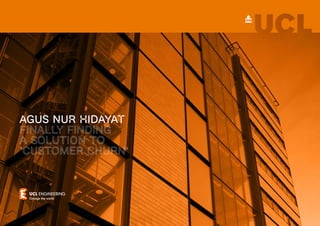
Case Study - Agus
- 1. AGUS NUR HIDAYAT FINALLY FINDING A SOLUTION TO ‘CUSTOMER CHURN’
- 2. AGUS NUR HIDAYAT FINALLY FINDING A SOLUTION TO ‘CUSTOMER CHURN’. Exploiting Predictive Analytics to Suggest the Solution for Customer Churn: Contact Lense Online Store. Research says that obtaining new customers costs more money compared to maintaining the ones in existence. The measurement to comprehend how well a company is maintaining existing customers is the rate of ‘customer churn’. In other words, how many of customers stop transacting with the company within a particular time-span. Knowing which customers will churn can facilitate a pre-emptive intervention. Additionally, determining customer segmentation independently can lead to tailored customer interaction. Thanks to the availability of raw data owned by the company, all of those tasks can be addressed efficiently by the use of predictive analytics. Task: The project involved the consultation and collaboration with a (confidential) online contact lenses store, an industrial partner, Streamline Intelligence and the academic oversight of the UCL Computer Science Facility. We posed the following research questions: 1. How do you build a model that can predict churned customers? 2. How can you determine the causal rules of significant features that trigger churned customers? 3. How could you decide the interventions towards the churned customers? And used the Predictive Analytic Models: Conditional Inference Tree (churn prediction), K-Means Clustering (churned customers’ segmentation), Logistic Regression (evaluating models). Review: The project led to descriptive insights from the exploration of data, creating a business and statistical definition of churn which was not previously available from the raw data. It produced a classification model for churn prediction, a clustering model for the segmentation of churned customers and an interpretation of all the models which could help prescribe customer interventions.
- 3. What makes this project unique? The client had many different products within its online range, all of which had different rates of churn. The challenge was to create a unified model which could be applied across the whole business. We selected variables to use in the model and ran a range of predictive analytic techniques to see which was the best predictor. The aim was to create models that are easy for the client to understand in the context of their own business. What was the moment you realised you wanted to do what you are doing today? I worked as a software engineer before, in a position which involved building database systems. The raw data is often used by companies for operational purposes without ever realizing its potential use as a strategic asset. I wanted to learn how to extract the insights from this raw data and how to interpret it properly to provide insights that are actually helpful to the company in terms of their business decision- making process. What has been a highlight so far? My decision to study overseas at UCL has been really important. Not only has it strengthened my skill set with a Master’s degree from a top university but meeting so many new people from different backgrounds has definitely widened my perspective. What have you learnt along the way? Stop wasting your time by blaming yourself after failing. If you don’t fail, you don’t learn. Rather than being gloomy, learn from your mistakes and be a better version of yourself. And if opportunity doesn’t knock, build a door. What excites you about the opportunities with data today and in the future Reliable data can help prevent the cloudy business assumptions that can mislead both customers and the actual employees of the company. In my opinion, the satisfaction of customers and employees are two key factors that drive the success of a company. Rather than solely trying to develop sophisticated algorithms to improve the results of of learning models, we should also explore how the models themselves can be applied to and impact business decision- making. //// QA WE SAT DOWN WITH AGUS AND ASKED HIM A FEW QUESTIONS ABOUT HIS PROJECT AND ASK WHAT HE THINKS THE FUTURE HOLDS FOR HIMSELF. “Meeting so many new people from different backgrounds widened my perspective”
